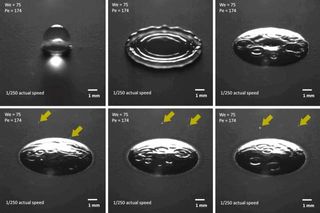Why Rain Gives Off That Fresh, Earthy Smell

Walk through the first rainstorm of the season and it slowly hits you: that fresh, earthy smell.
Before it hits the ground, rain is just water. It has no smell. But after the drops hit the ground and interact with dirt, the fresh and almost sweet fragrance of rain is let go. Now, scientists think they've identified the exact mechanism that releases this aroma into the environment.
The smell actually has a name. It's called "petrichor," from the Greek words "petra," meaning "stone," and "ichor," which refers to the fluid that flows like blood in the veins of the gods. The phenomenon was first characterized (as the familiar smell after a light rain) by two Australian scientists in 1964, but until now, researchers didn't understand the physical mechanism behind it. [Fishy Rain to Fire Whirlwinds: The World's Weirdest Weather]
"They talked about oils emitted by plants, and certain chemicals from bacteria, that lead to this smell you get after a rain following a long dry spell," Cullen Buie, an assistant professor of mechanical engineering at the Massachusetts Institute of Technology in Cambridge, said in a statement. "Interestingly, they don’t discuss the mechanism for how that smell gets into the air."
When a raindrop hits a porous surface it traps tiny pockets of air. These bubbles then speed upward, like bubbles in a glass of champagne, before breaking the drop's surface and releasing microscopic particles, called aerosols, into the air. The researchers think these aerosols carry the rainlike aroma.
Buie and his postdoc, Youngsoo Joung, filmed raindrops as they hit 38 different types of surfaces: 12 engineered materials and 16 soil samples. Joung even sampled soil from around MIT's campus and along the Charles River.
The researchers observed the process with a system of high-speed cameras. Depending on the speed of the droplet, and the properties of the soil, a cloud of hundreds of aerosol droplets might be dispersed in as little as a few microseconds. The researchers saw this most often during light and moderate rain, while far fewer aerosols were released during heavy rain.
Sign up for the Live Science daily newsletter now
Get the world’s most fascinating discoveries delivered straight to your inbox.

Scientists have long observed that raindrops can trap and release aerosols when they fall on water, but this is the first time they've observed the process happening on soil.
The new research "brings the conversation of bubble-induced aerosol formation from the ocean over to the land," said James Bird, an assistant professor of mechanical engineering at Boston University, who was not involved with the study. "Microbes from soil have been observed high in the atmosphere; this paper provides an elegant mechanism by which these microbes can be propelled past the stagnant layer of air around them to a place where the breeze can take them elsewhere."
The researchers think aerosols not only spread noticeable aromatic elements, but also certain contaminants, such as soil-based viruses and bacteria. Their future work will focus on just how easily and far these contaminants can spread.
The findings were published Jan. 14 in the journal Nature Communications.
Follow Shannon Hall on Twitter @ShannonWHall. Follow Live Science @livescience, Facebook & Google+. Original article on Live Science.
Most Popular


